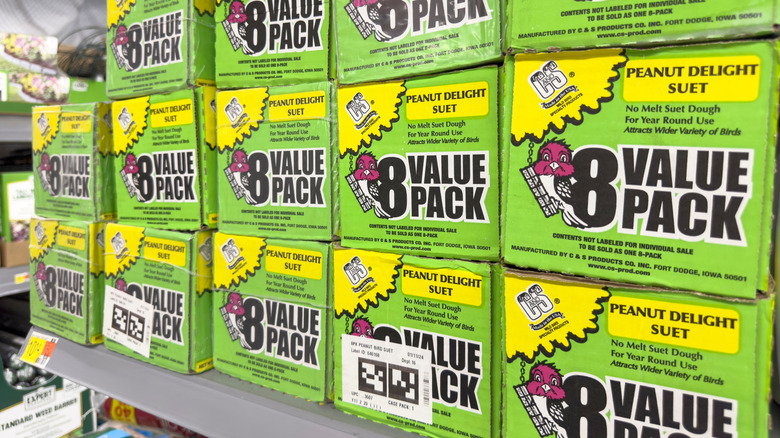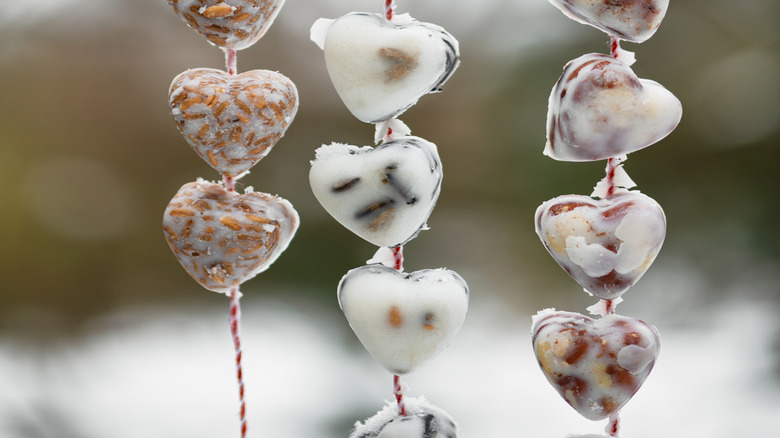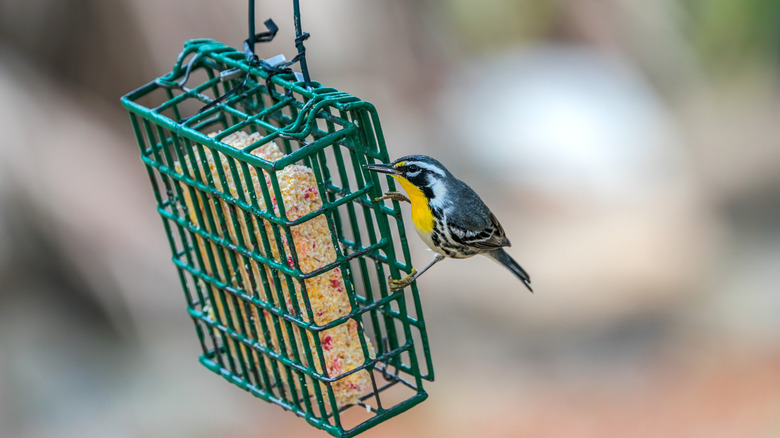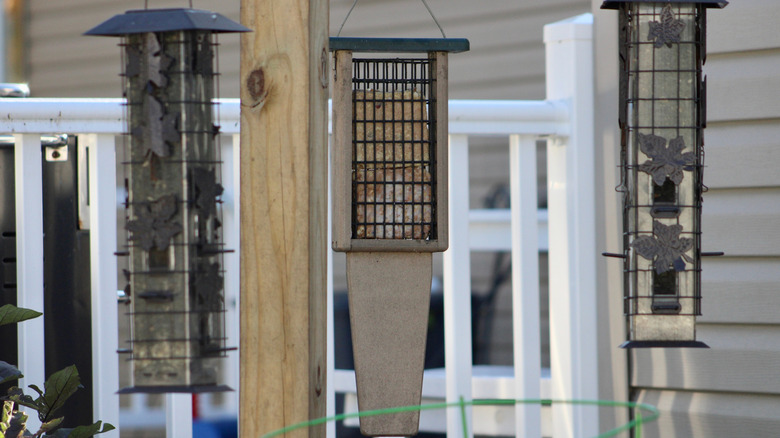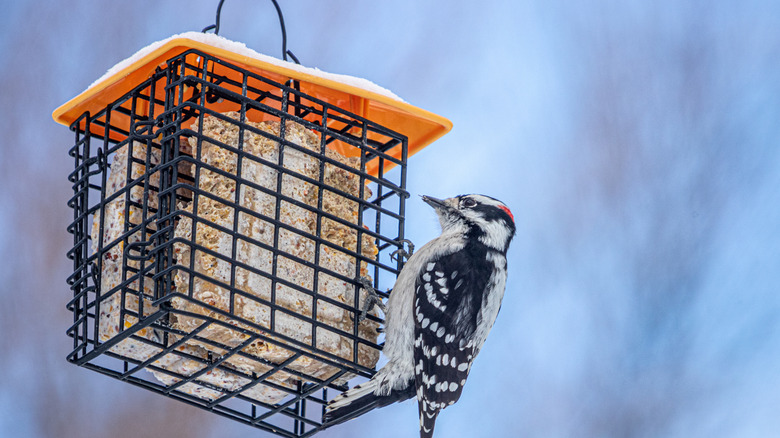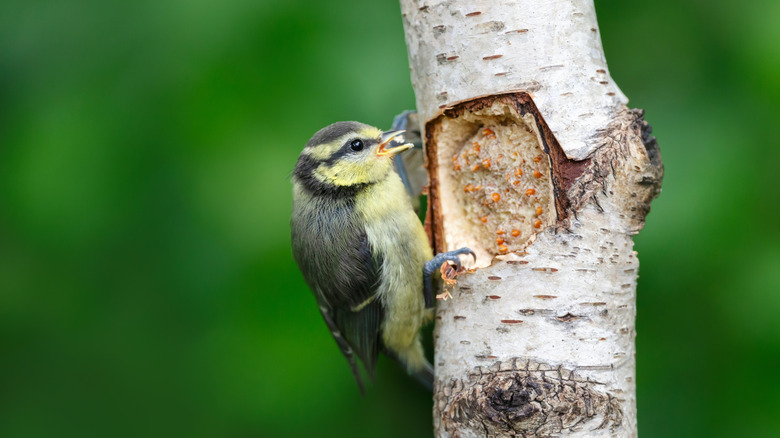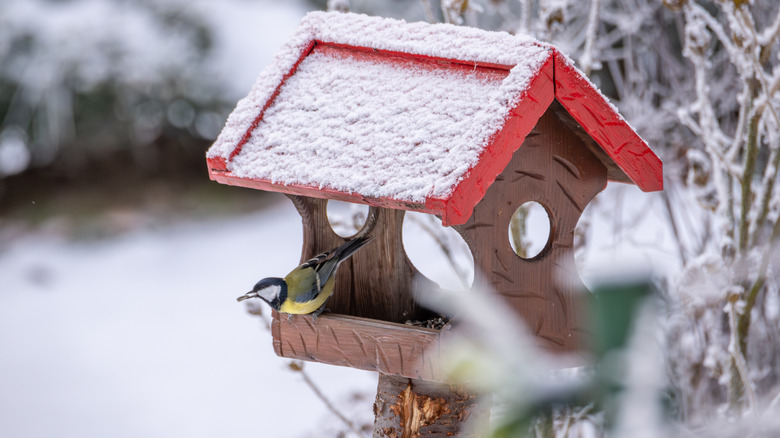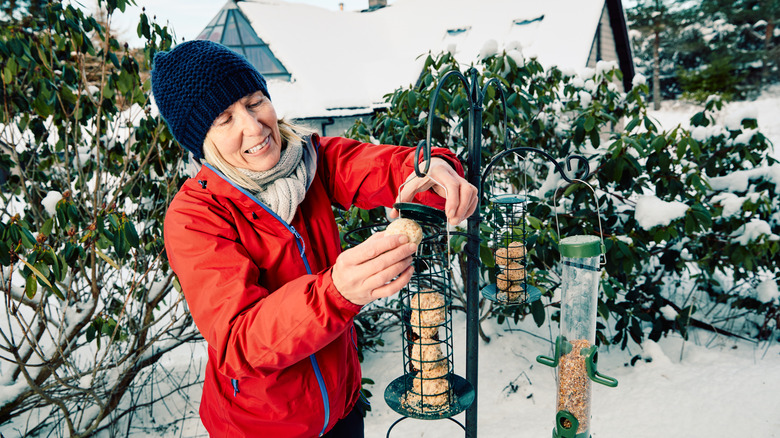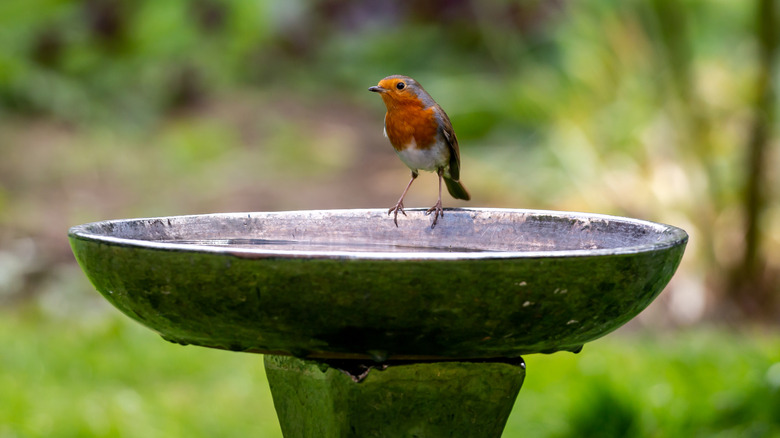9 Ways To Attract More Birds To Your Yard With Budget Friendly Suet
Looking for ways to attract more feathered friends to your yard? Suet is an option that works particularly well in the cooler months for specific types of birds, particularly woodpeckers, nuthatches, and chickadees — birds that love insects are prime suet eaters. Each gram of suet offers about 9 calories of fat, making it an energy-rich source during the winter months when food is difficult to find. The fat content also makes suet susceptible to melting or going rancid in the warmer months, which is why it's mostly used during winter. That being said, there are no-melt versions available that can make it a suitable year-round option.
Strictly speaking, the word suet refers to beef and mutton fat that's found around the kidneys and loins. But if you're an aspiring birding expert, you probably envision the little cakes of seeds and other goodies that you can purchase at the store. Those commercially produced cakes often contain various forms of animal fat, along with other bird-friendly ingredients like nuts and berries. They're often effective at attracting and feeding birds, and you can also make a homemade version if you want more control over the ingredients.
However, there are some potential issues that could scare away birds or make your yard less appealing, even if you fill it with suet. From choosing the right ingredients and the correct suet holder (with or without a tail prop) to hanging it in the best spot and providing other necessary resources, the way you use suet affects your success. If you're new to the world of suet for birds, the following tips will help you attract more feathered visitors to your wintery backyard.
Look for the right ingredients in suet
Pre-made suet comes in a wide range of shapes and formats, from balls to cakes. You can also get specialty options, like plugs, that fit into special log feeders, or crumbles and nuggets to fit your preferred feeding method. But beyond the shape and format, it's the nutritional content and ingredients that matter when you want to attract a wide range of birds and keep them coming back for more. High-fat options are essential during the winter months — the birds who visit your suet feeders need the fat as an energy source in cold conditions. Remember when we said the strict definition of suet is hard animal fat? That's a major ingredient you want in your pre-made cakes to deliver energy to birds.
When choosing suet, look for options with as much fat as possible — 95% fat content is ideal. Check the ingredients list to look for suet or rendered beef fat for a high-quality option. There are also ingredients you should skip, particularly palm oil, since its production is often associated with devastating deforestation. If you want to make sure your suet contains simple, high-quality ingredients with a high fat content, you can make your own using melted beef fat. There are several recipes that allow you to DIY a suet block to feed your outdoor bird friends with ingredients including bird seed, dried fruit, peanuts, and oats.
Use different ingredients with your suet to attract particular birds
Any suet cake should attract birds, but some types of feathered visitors prefer specific ingredients. What you need in your suet blend to attract woodpeckers is different than what you should include for orioles. For example, peanuts are a big hit with woodpeckers. Meanwhile, fruits and berries are more attractive to orioles, robins, and bluebirds. If you're looking to attract those bird species (or if you want a wider variety of birds in your backyard), customizing the ingredients in your suet cakes could be the answer.
Start by understanding what types of birds are common in your area — this helps you know how to customize your suet in a practical way. Then, decide which types of birds you specifically want to attract, and select pre-made suet products that contain ingredients that appeal to those species. Choose options with suet or rendered fat, peanuts, and sunflower seeds to bring in blue jays, chickadees, woodpeckers, and tufted titmice. Opt for primarily suet and sunflower seeds if you want to see nuthatches. The Carolina wren is a fan of suet with peanut butter. Stick with fruit-heavy options if you want to see orioles, bluebirds, and robins. Making homemade suet lets you customize the ingredients if the pre-made varieties are limited at your local stores. You can also use several different recipes to expand on how many bird species you draw to your yard.
Pick an effective suet holder
Technically, you don't need a specialty suet feeder — you can hang a cake on a string or smear a soft suet mix on a surface. However, feeders often make it easier for the birds to eat, which could make your yard an appealing place for a meal, and some types of feeders can help keep away unwanted visitors as well. For instance, starlings love suet, but they often scare away other birds because of their large size and aggressive nature. That's why the European starling isn't a bird breed you'll want in your backyard. Certain types of feeders are more difficult for starlings to use, so choosing those options makes your suet more inviting for a wider variety of smaller birds. Most suet feeders you'll find look like wire cages, allowing the birds to wrap their feet around the wires and put their beaks through the openings. However, there are other options to consider.
Choose a feeder based on the unique needs in your backyard and your preferences for feeding birds. If starlings are a problem in your backyard, choose special suet feeders designed for upside down hanging to reach the food. The starlings won't be able to hold themselves upside down, but other clinging birds will. Buy a larger suet holder designed for space for several suet cakes if you have a busy backyard. An inexpensive option is a mesh bag that holds suet — it's a cost-effective option if you want to offer suet on a budget or want to fill your yard with several feeding stations.
Add a tail prop
When done well, offering suet attracts a range of birds in different sizes that use different feeding methods. Woodpeckers, in particular, benefit from extra tail support on a traditional cage-style suet feeder. When they feed on trees, woodpeckers use their tail feathers to support themselves as they peck for insects. Regular suet feeders don't have a surface below the cage that can be used for support. However, there is an easy solution: You can buy suet feeders with built-in support below the cages.
If woodpeckers are your primary target for your backyard suet feeder, look for an option with a built-in tail prop — it's usually a board that extends about 6 inches below the area where you put the suet. It provides similar support as the trunk of the tree, and allows the woodpeckers that stop for a nibble to lean their tail feathers against the prop. This provides them with a more natural position for eating. Add a suet cake with peanuts for an extra-special treat for woodpeckers. You may notice that you attract more woodpeckers and that they stay at the feeder longer when you add a tail prop.
Hang suet in a safe, attractive location
The location impacts how safe the birds are while they're eating and how likely they are to come back. Putting it close to your home for convenience could also increase the risk of birds colliding with windows as they fly toward the feeder. Remember that the bird food is made largely of animal fat, which will attract carnivores like your pet dog. If you hang the feeder too low, they may try to take a nibble — and they could grab a feeding bird at the same time. It's also potentially dangerous to locate the feeder too close to cover where predators could hide. Birds will feel safer to approach a suet feeder that is away from potential dangers. Safe locations allow for a good experience for the birds, which keeps them coming back. Plus, it protects the well-being of the birds that visit.
For a safe, appealing location, hang suet feeders at least 5 to 6 feet off the ground to keep them out of reach of dogs and other potential predators. Place the feeders away from brush or ground cover where predators could hide, yet close enough (within a few feet) of cover for the birds where they can retreat from danger or rest safely. Position the feeder closer than 3 feet or farther than 30 feet from windows, particularly glass that has a reflective surface. Avoid positioning the suet where it will be in direct sunlight for long periods of the day — the sun could make it melt or go rancid.
Make a log feeder
If you don't want the expense of buying a suet feeder (or you don't want to worry about what you should be using to clean your suet bird feeder), you can go a more natural route. While it is an option to spread the suet on branches or pine cones as a way to feed birds, that can be potentially dangerous. Soft suet that's spread on branches or fully exposed to birds could coat birds' feathers with the greasy fat. That could cut down on how well the feathers insulate the bird and repel water, which could lead to hypothermia and starvation. If you want a suet bird feeder that will look natural in your trees, you can use log-style feeders, which have holes drilled in them where you can put the suet.
Log-style feeders and suet plugs to go in them are available for purchase. To make your own, use a branch or log that's about 3 inches in diameter and 2 feet long. Simply drill 1-inch-deep holes, and fill them with suet before hanging the log. If you don't want to mess with making a feeder, you can simply put the suet in a natural hole found in a tree to keep birds from landing on the suet and coating their feet and feathers with it.
Combine suet with other bird features
Making your backyard a bird-friendly destination year-round can help make your suet feeders more popular to the local feathered residents. One lonely suet feeder could entice a few hungry birds occasionally, but offering shelter and spots to rest for a while encourages the birds to linger. Once birds find your ideal backyard living conditions, they might return frequently and spend more time there. Native plants also offer a source of food that can supplement what's available in your suet and other bird feeders. Even the way you care for your landscaping and lawn could affect your bird population — many of the birds that seek out suet in the winter appreciate a heavy insect diet in the warmer months. Using insecticides can decrease the insects that the birds eat, and the chemicals could also harm birds.
The keys to a bird-friendly environment are food, water, and shelter. Providing those features can signal to birds that yours is a friendly yard where they want to spend time. Start by adding native plants (particularly varieties that supply seeds, berries, or other sources of food), while cutting back on invasive plants to grow the natural bird habitat in your backyard. If your property is short on trees, consider adding some for the birds that prefer hiding out higher off the ground. Incorporating nesting boxes and birdhouses also offers shelter for birds. Then, keep your suet feeders and other sources of food fully supplied and free of bacteria to keep the birds around.
Hang multiple suet feeders and other feeders
While suet feeders should fill your yard with insect-loving birds, including other types of feeders and food sources can help broaden the types of feathered friends you meet. Even if you want to focus mostly on suet-loving birds, adding multiple feeders could help you increase your backyard populations. It gives them plenty of food, and you can experiment with different locations to find out if some are more popular than others. Including multiple feeders in your yard also helps spread out the food so more birds can eat once — although you may still see birds squabbling over spots or swapping which feeders they use from one minute to the next.
Consider what types of birds you want to attract to ensure the feeders (and the food you put inside of them) fits their preferred diet. Otherwise, those species you want to see might pass your yard in favor of more appealing meals. Positioning the feeders at different levels can also appeal to a wider range of birds, depending on the height they prefer to eat at. For instance, sparrows prefer ground-level feeders, while titmice, woodpeckers, and chickadees (often the species that frequent suet feeders) want to eat higher, near the trees. A tube or hopper-style bird feeder allows you to serve up loose seed year-round. Black-oil sunflower seeds are a popular option for a wide variety of birds. Thistle is another popular option that can go into a tube feeder, but you can also put it in a platform feeder. Peanuts, dried fruit, and mealworms are other solid choices to complement your suet feeders and entice more birds to your yard.
Provide water with the suet
Water is essential for birds year-round, but, just like food, water can become more difficult to find during winter. That's why providing a source of water close to your suet feeders could make your yard extra appealing. Birds passing through can fuel up on energy-filled suet and take a drink to hydrate. If you live in a climate where the weather is below freezing frequently, you'll need a plan for keeping the water from freezing.
Adding a bird bath to your yard is a simple and safe way to provide water to birds. Choose a shallow vessel that only allows about 1/2 to 1 inch of water to accumulate inside. To prevent it from freezing solid and keep the source fresh, change the water daily. Even if you don't live in a frigid climate, it's a good idea to check the water levels daily, especially when it's windy, to make sure there's plenty of water remaining. You can also install a heater to ensure the water doesn't freeze, or choose a dark-colored bath and place it in the sun to absorb more heat.

